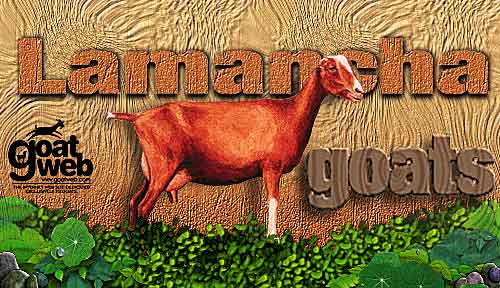LaMancha Goats
August 21, 2012 by pwadmin
Filed under Goat Breeds
American Dairy Goat Breed Description
The LaMancha goat originated in the U.S.A. It has excellent dairy temperament and is an all-around sturdy animal that can withstand a great deal of hardship and still produce. Through official testing this breed has established itself in milk production with high butterfat.
The LaMancha face is straight with the ears being the distinctive breed characteristic. There are two types of LaMancha ears. In does one type of ear has no advantage over the other.
1. The “gopher ear” is described as follows: an approximate maximum length of one inch (2.54 cm) but preferably nonexistent and with very little or no cartilage. The end of the ear must be turned up or down. This is the only type of ear which will make bucks eligible for registration.
2. The “elf ear” is described as follows: an approximate maximum length of two inches (5.08 cm) is allowed, the end of the ear must be turned up or turned down and cartilage shaping the small ear is allowed.
Any color or combination of colors is acceptable with no preferences. The hair is short, fine and glossy.
The LaMancha may carry a little more flesh than the Swiss breeds do, but not as much as the Nubian. LaMancha ears are the most obvious breed difference. They almost do not exist. Gopher ears, which are a must on bucks, contain no cartilage. They appear as wrinkled folds of skin that lie close to the head. Elf ears, which may be found on does, come in many shapes and sizes, contain cartilage and skin, and they must look very small in comparison with the size of the doe’s head. The head and muzzle should be wide, as in the other breeds, and the nose will probably be concave. Any coat color is acceptable, and the hair is short and fine.
ORIGIN: American by mutation; originals from Spain.
National Breed Club
Judith Hoy, Sec-Treas.
1924 Mt. Pleasant Road
Port Angeles, WA 98362-9364
360-452-5903
star@olypen.com
Dues: $15
Our goal is to promote the LaMancha dairy goat & assist all LaMancha dairy goat owners & breeders including commercial dairymen, cheese producers, exhibitors, & hobby enthusiasts. The ALC provides annual awards for production, the All-American program, & seeks to recognize the efforts of those who contribute to the breed. Our bimonthly newsletter (also provided on audio tape for the visually impaired) includes a special membership issue & annual buck catalog.
Visit our Breeds & Breeding forum section and our milking section!


we have a la mancha goat she is about 2 months old we are noticing that she is itching her self behind her back of her shoulders & she is loosing hair in spots where she itches. We don’t see bugs moving, she has a good appetite & very friendly. What are the causes & what are the treatments she can give her so she is healthy. Thank you